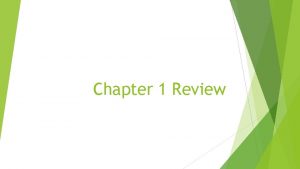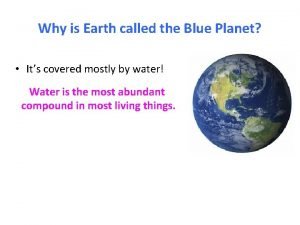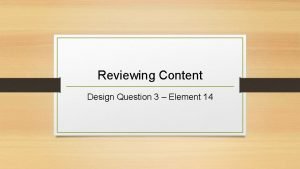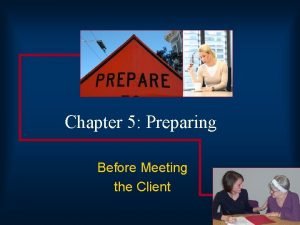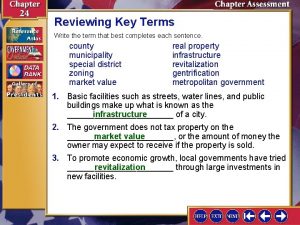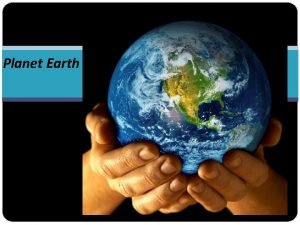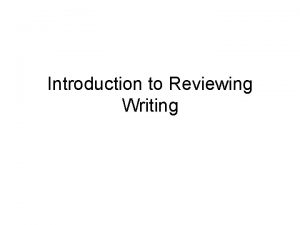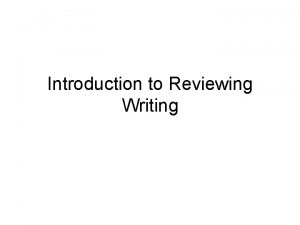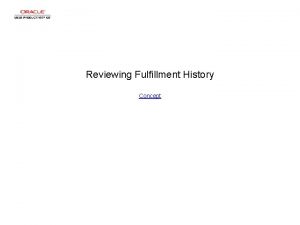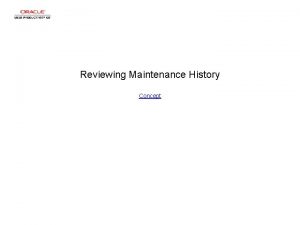Reviewing Chapter 1 Planet Earth Measuring the Earth









- Slides: 9

Reviewing Chapter 1: Planet Earth (Measuring the Earth)

The shape of the Earth: • Oblate Spheroid (though we LOOK like a perfect circle!) • Slightly wider across the Equator. The Structure of the Earth: • Litho- hydro- and atmosphere = crust, water and air. • See p. 10 in the ESRTs.

Locating positions on Earth • Latitudes = parallel lines. Equator = 0 degrees, NP and SP = 90 degrees N and S. • Longitudes = meet at the Poles. Prime Meridian = 0 deg. Total number = 180 deg East/West. • Our latitude and longitude measurements = our angle from the Equator and Prime Meridian. (see p. 16)

Useful info: • You can always tell your latitude if you can find Polaris. (Polaris’s altitude = your latitude. ) This is only true for places north of the Equator. • You can find Polaris (the North Star) by finding the last 2 stars in the Big Dipper’s “cup. ” See p. 17. • You can also find NORTH by finding Polaris! Or…by using a compass. (There is a slight incorrectness to the direction of “true north. ”)

Solar Time/Clock Time • There are 24 time zones on Earth…. and 24 hours in a day! • The Earth turns 15 degrees/hour…so there is a new “time zone” every 15 degrees of LONGITUDE. • If you know the solar time on the Prime Meridian and your own solar time, you can figure out your approximate longitude.

Maps • Scale = the ratio of how a real object’s measurements compare to that on a map. • Maps can be made for many types of measurements…. elevations, temperatures, air pressure, pollution concentrations…. • Contour lines are used to show elevations…. . like on a topo map. (more on the next slide!)

Contour Maps • Special things about contour lines: • Close lines = steep slopes! (also – close lines on ANY isoline map = high gradient!) • When contour lines cross rivers, they bend UPHILL! • Closed circles = hills. • Always, the interval (difference in value from one line to the next) is the SAME on a map.

Making a Profile from a Topo map: • The profile represents a slice across a landscape. • Use the edge of a piece of paper to make marks representing each place a contour line touches the profile line. (see p. 24!) • Transfer this info onto the profile grid. • Don’t forget to make note of the measurements before you try to make the profile!

Gradient/Slope • Formula = change in field value/distance (p. 1 in ESRTs. ) • Don’t forget the units!!! It depends on the field you are measuring (is it elevation? Is it degrees? Is it ppm? . . . ) and the distance you are measuring (is it km? miles? cm? . . . )
 Chapter 5 section 4 the minor parties reviewing key terms
Chapter 5 section 4 the minor parties reviewing key terms Reviewing concepts and vocabulary chapter 1
Reviewing concepts and vocabulary chapter 1 Why earth called blue planet
Why earth called blue planet Marzano design questions
Marzano design questions Preparatory empathy examples
Preparatory empathy examples Reviewing key concepts reproductive barriers
Reviewing key concepts reproductive barriers Reviewing key terms
Reviewing key terms Reviewing and correcting the final draft of a message is
Reviewing and correcting the final draft of a message is Febabook
Febabook Chapter 20 patient collections and financial management
Chapter 20 patient collections and financial management

